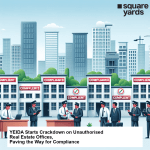Noida and Ghaziabad Predict Big Revenue Jump from Transit Oriented Development (TOD) Policy
Noida and Ghaziabad are set to experience a significant boost in revenue and rapid transformation in their urban landscapes thanks to the Transit Oriented Development (TOD) policy, as highlighted by Finance Minister Nirmala Sitharaman in her recent budget speech. Uttar Pradesh already implemented its own transit policy back in 2022, designating areas within 500m of intra-city mass transit systems (such as metro corridors and bus routes) as a TOD zone. For intercity transit projects like rapid rail and metro, the TOD zone expands to 1.5km on both sides of the corridors.
Promoting Properties and Encouraging Public Transport Usage
The primary objective of the TOD policy is to encourage the development of residential and commercial properties along transit routes, aiming to facilitate pedestrian accessibility to stations and promoting the use of public transportation. This policy becomes even more critical for Noida, which is home to the upcoming international airport in Jewar along with various allied transit systems such as the metro, expressway, pod taxis, and rapid rail. Ghaziabad, on the other hand, will focus on the 17km rapid rail section, which is already operational, and will soon witness the operationalization of the Namo Bharat corridor from Sarai Kale Khan in Delhi to Meerut within the next year.
Beneficial Incentives for Developers
Developers who undertake projects in the TOD zones can expect to receive certain advantages. For instance, the Floor Area Ratio (FAR) will see a significant increase (ranging from 33-50%) from the prevailing 1.5, and the licensing process will be expedited to facilitate faster project implementation. Ghaziabad, which is expected to witness a 45km Namo Bharat corridor by the end of this year, anticipates an annual revenue of Rs 1,500 crore from projects in the TOD zone. In fact, the increase in FAR alone is likely to lead to an almost 200% rise in revenue from mixed land use in TOD zones, according to RK Singh, Ghaziabad’s former district magistrate and the former GDA vice-chairperson. The revenue generated from TOD zone projects around the rapid rail network will be divided between GDA and the NCR Transport Corporation, with GDA using these funds for its own respective development projects.
Noida’s and Ghaziabad’s Respective TOD Zones
The TOD zones in Ghaziabad are spread across various locations in the district, including 650 hectares near Sahibabad station, 477 hectares along Ghaziabad, 818 hectares near Guldhar, 720 hectares off Duhai, and 376 hectares near Muradnagar. The Noida region, on the other hand, is eagerly anticipating the benefits of the planned 72km rapid rail corridor connecting to the Jewar airport via Greater Noida West, as well as the 28km pod taxi/light rail from Pari Chowk. The Yamuna Expressway Authority’s master plan for the next two decades designates areas within 500m of the Neo Metro route as TOD zones.
Increase in FAR and Projected Revenue Growth
In line with Ghaziabad, Noida is also projected to witness an increase in FAR within its TOD zones. Whereas the industrial sector typically has an FAR in the range of 1-1.5 in other parts of the city, it is expected to rise to 2.5 in proximity to transit systems. Similarly, in the commercial category, FAR is likely to reach up to 4 in the TOD zones. Prabhakar Kumar, the business head of urban development at Rudrabhishek Enterprises, stated that this increased FAR, coupled with higher taxes and other bills, is expected to contribute to a 60-70% increase in generated revenue. The impact will be particularly pronounced in areas where commercial and residential developments are concentrated, especially near the transit stations. In areas along the Yamuna Expressway, which are yet to witness significant development, the TOD policy is expected to have an even more significant impact.
Future Economic Prospects
The implementation of the Transit Oriented Development policy in Noida and Ghaziabad holds tremendous promise for the economic growth and urban development of these regions. It aligns well with the government’s vision of developing sustainable, integrated transport networks and promoting the use of public transportation. By associating revenue streams with TOD zone projects, the local authorities can further invest in infrastructure development projects. Overall, the revenue jump expected from the TOD policy showcases the potential for economic advancements and improved living standards in the region, raising hopes for a seamless and efficient transit system that benefits both residents and businesses alike.
























